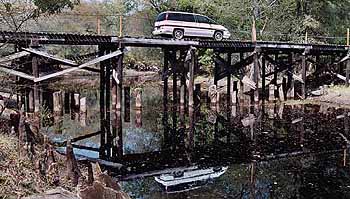HISTORY OF PASCO COUNTYThe Lanier Bridge Researcher Robert Dew found that in 1855 Lanier patented property at what is now Socrum in Polk County. Dew suggested that the bridge may have been built to facilitate his move to Polk County and for shipment of his produce. Dew believed that slaves belonging to other Laniers in what is now Polk County may have built the bridge. In a 2005 email, he noted that the 1850 census shows that James Lanier owned only one adult slave, a 30-year-old female. He also owned an 11-year-old male, a 6-year-old female, and three 5-year-old males. Susan McMillan Shelton from the Lanier family of River Road writes:
County commission minutes of April 2, 1888, have: “It was ordered that John Sumner repair Lanier Bridge at $2.00 per hundred feet of lumber.” The bridge is mentioned by name in the Tampa Morning Tribune of Feb. 27, 1918. An article reported that an oil well would be sunk “near the Lanier bridge across the Withlacoochee river, about four miles east of [Dade City].” In an account by Zachary Taylor Roberts (1848-1937) of his arrival here, he refers to “Lanier’s Bridge.” In a 1923 article in the Dade City Banner Roberts recalled arriving here in 1884 and wrote, “At the Lanier bridge I parted company with [T. F.] Williams, he going to his ranch, near J. W. Tuckers while I took the road for Dade City.” The bridge has been replaced several times. In a 2011 message on facebook, Al Pike wrote, “When I was in the National Guard in Dade City we would go out past the bridge and practice our single and double rope river crossings at the river. It was really scary in those old Army trucks crossing that bridge. You could feel it giving as the weight of the trucks moved across it. Even scarier was when we’d get to the river and have to run the gators off to cross the river. That gave us plenty of incentive not to fall off the ropes. This was in ’73-’76.” The photo above, by Dan McDuffie, appeared in a March 7, 2000, St. Petersburg Times article which reported that the current wooden span, built sometime in the 1940s, would be replaced by the end of the year with a concrete bridge by the Southwest Florida Water Management District. Pictures of the bridge are e1498, e1499, e1501 (all probably 1920s), e1660 (1990s), e1659 (2009), e1661 (about 2011). |
